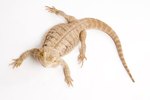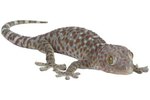
Fresh-air habitats, featuring screen rather than glass or plastic walls, are primarily used for chameleons. Most chameleons do not thrive in aquariums, due in part to their need for substantial airflow. Fresh-air habitats provide the highest possible air quality for captive reptiles and can serve a number of other reptile species as well.
Construction
A "fresh-air habitat" is simply a secure cage whose walls allow free passage of air into and through the cage. Most fresh-air cages have walls of metal mesh or screen and framing of metal, plastic or wood. Some commercially produced metal open-air cages are constructed with very fine screenlike mesh, and some have plastic-coated wire walls with gaps large enough to slip your finger or fingers between. The cage you choose for a reptile needs to have small enough gaps to contain not only your pet but any feeder insects as well.
Thermal Considerations
The husbandry of most reptiles includes providing an ambient cage temperature in the low 70s to low 80 degrees Farenheit and a high-temperature basking spot of 90 degrees or more. The goal is to establish a thermal gradient that allows your pet to select the most comfortable temperature. Fresh-air habitats excel for creating dramatic thermal gradients because of the constant air exchange with the “outside” world. This allows you to blast a basking spot with a high-temperature bulb and still maintain proper ambient temperatures away from the basking spot. The flipside is that it can be more difficult and expensive to heat an open air habitat than an enclosed habitat. In some cases, this difficulty can be overcome by utilizing a low-power heat source to heat the ambient cage temperatures or keeping the fresh-air cage in a warmer room.
Humidity
Humidity is a concern for a fresh-air habitat, as any water added to the air in the cage promptly diffuses right back out of the cage. If your pet hails from a rainforest, regular and thorough misting will be necessary to maintain an appropriate humidity. Additionally, you'll do well to include live plants in the cage, as they will draw water via the roots and expel water vapor from the leaves.
Species
Captive turtles and tortoises commonly live in fresh-air habitats. Snakes can inhabit mesh cages if the mesh is very smooth; otherwise snakes will quickly hurt themselves by rubbing their noses on rough surfaces. Open-air habitats are most often used for chameleons, but they work well with many other tropical rainforest species. For home open-air husbandry, use lizards from a climate similar to your own. If you live in the deserts of California or Arizona, open-air caging may work with species like bearded dragons (Pogona vitticeps) and banded geckos (Coleonyx sp.). Likewise, keepers in south Florida are well suited to keep tropical species like frilled dragons (Chlamydosaurus kingii) and green baskilisks (Basiliscus plumifrons) in fresh-air habitats. If you live in a very cold and dry location, it may not be feasible to keep any species in an outdoors habitat. Your geography impacts use of a fresh-air habitat outdoors more than it does any other cage style.
References
Photo Credits
-
Jupiterimages/liquidlibrary/Getty Images



